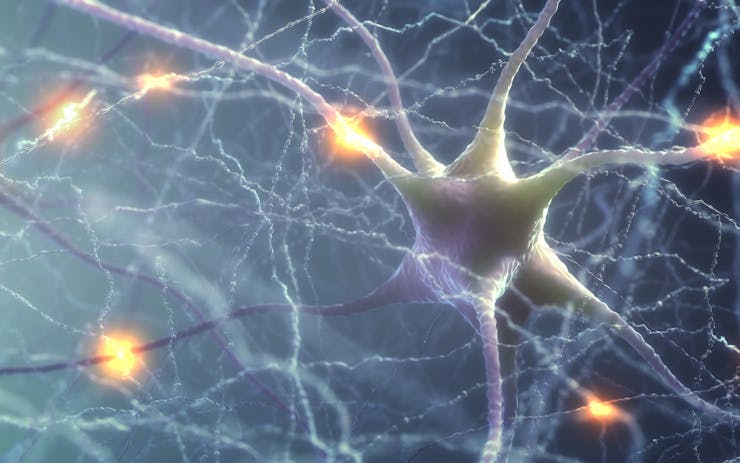Most people who have dipped their toe in cannabis science understand that cannabinoids like THC and CBD interact with traditional cannabinoid type I and II (CB1 and CB2) receptors. However, these are not the only receptors that cannabinoids target.
A “newly discovered” target called GPR55 has emerged as a major contributor to many of cannabis' actions in the brain and body.
CBD in particular has a wide range of therapeutic benefits because of its numerous targets other than CB1 and CB2 receptors throughout the brain and body. For instance, it reduces anxiety by boosting the brain’s serotonin system, and CBD activation of TRPV1 channels helps reduce pain. But a “newly discovered” target called the G-protein coupled receptor 55, commonly referred to as GPR55, has emerged as a major contributor to many of cannabis’ actions in the brain and body, including CBD’s benefits in preventing seizures and combating cancerous tumors.
The Discovery of GPR55
GPR55 was first identified in 1999. At the time, no one knew what its function was or how it was activated. But in 2007, it was revealed that CBD and other cannabinoids can affect its activity. Both the high-inducing chemical, THC, and the endogenous cannabinoids, anandamide and 2-AG, can activate GPR55. CBD, on the other hand, blocks GPR55 activity. All of these cannabinoid actions on GPR55 has made some in the research community consider it as a novel cannabinoid receptor and perhaps the third in the set (i.e., CB3).
There hasn’t been a firm commitment to this new nomenclature. GPR55 only shares 14% similar identity to CB1 and CB2 receptors (for comparison, CB1 and CB2 are 64% similar), and looks a bit different from CB1 and CB2 receptors in the region that interacts with cannabinoids, creating some controversy over how certain cannabinoids affect GPR55. But nonetheless, it seems to have an important role in the therapeutic benefits of cannabis, particularly CBD.
GPR55’s Role in Epilepsy
CBD has emerged as a promising anti-epileptic treatment strategy in seizuredisorders that don’t respond well to traditional medications. In cases like Dravet syndrome, mutations in DNA cause a reduction in the level of brain inhibition which manifests as epileptic seizures. (You may have heard of Charlotte Figi, the young girl with Dravet syndrome whose seizures were successfully treated with CBD-rich cannabis and is now the namesake of the popular Charlotte’s Web.)
Despite the exciting anecdotal and clinical trials demonstrating CBD’s effectiveness, they don’t reveal how the drug works. To understand the mechanism by which CBD may reduce seizures, our research team tested a genetic mouse model of Dravet syndrome. We revealed that CBD restores brain inhibition and reduces seizures largely by blocking the activity of GPR55 in the hippocampus, a critical brain region for seizure activity.
GPR55 and Cancer
GPR55 has an increasingly appreciated role in cancer. Because of GPR55’s novelty, many of these studies are in their early stages and haven’t been translated to animals or humans yet.
However, in verified cell lines—which is often the first stage of cancer research—GPR55 activation is thought to have pro-tumor effects while blockade of GPR55 activity (i.e., the effects of CBD) has anti-tumor effects in colorectal cancer, breast cancer, pancreatic cancer, and brain cancer. CBD’s direct effect on these cancers remains an exciting yet untested future direction of cancer research.
GPR55 and Inflammatory Bowel Disease
Inflammatory bowel disease is the inflammation of the colon and intestines. Crohn’s disease and ulcerative colitis are the most common, and patients who suffer from these diseases have elevated GPR55 levels. This suggests that GPR55 may be having a pro-inflammatory role in the intestines. Indeed, blocking GPR55 activity in mice reduces gastrointestinal inflammation, perhaps underlying why CBD is becoming an increasingly popular treatment strategy for patients with inflammatory bowel disease.
Shop highly rated dispensaries near you
Showing you dispensaries nearCBD’s blockage of GPR55 activity may also contribute to its ability to reduce inflammatory and neuropathic pain. Mice that are genetically unable to produce GPR55 receptors have lower levels of inflammation, inflammation-induced pain, and neuropathic pain after nerve constriction.
How Does GPR55 Affect Cells?
GPR55 is a member of the class of receptors called metabotropic receptors. When these receptors are activated, they lead to a variety of downstream effects in the cell that often depend on what cell type is being tested. For GPR55, the extent of these downstream actions remains unclear across different cell types.
But because of its therapeutic relevance in CBD’s effects, it is a burgeoning area of scientific investigation which will provide an even stronger foundation for CBD’s medicinal benefits. You’ll undoubtedly be hearing more about GPR55 in the future!








